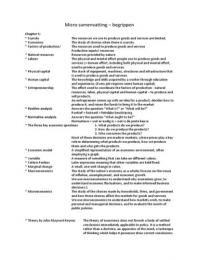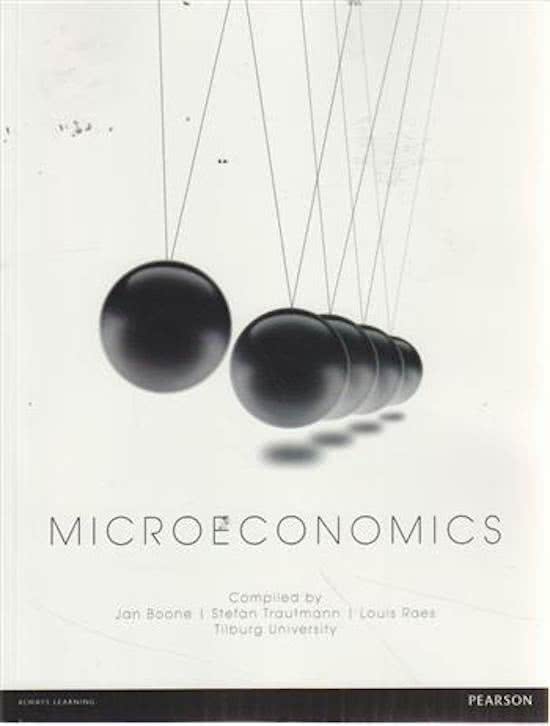Micro samenvatting – begrippen
Chapter 1:
* Scarcity The resources we use to produce goods and services are limited.
* Economics The study of choices when there is scarcity.
* Factors of production/ The resources used to produce goods and services
Production inputs/ resources
* Natural resources Resources provided by nature
* Labour The physical and mental effort people use to produce goods and
services (= Human effort, including both physical and mental effort,
used to produce goods and services.
* Physical capital The stock of equipment, machines, structures and infrastructure that
is used to produce goods and services.
* Human capital The knowledge and skills acquired by a worker through education
and experience. (Every job requires some human capital).
* Entrepreneurship The effort used to coordinate the factors of production - natural
resources, labor, physical capital and human capital – to produce and
sell products.
An entrepreneur comes up with an idea for a product, decides how to
produce it, and raises the funds to bring it to the market.
* Positive analysis Answers the question “What is?” or “What will be?”
Positief = factueel = feitelijke beschrijving
* Normative analysis Answers the question “What ought to be?”
Normatieve = wat er nodig is = wat is de juiste keuze
* The three key economic questions 1. What products do we produce?
2. How do we produce the products?
3. Who consumes the products?
Most of these decisions are made in markets, where prices play a key
role in determining what products we produce, how we produce
them and who gets the products.
* Economic model A simplified representation of an economic environment, often
employing a graph.
* Variable A measure of something that can take on different values.
* Ceteris Paribus Latin expression meaning that other variables are held fixed.
* Marginal change A small, one-unit change in value.
* Macroeconomics The study of the nation’s economy as a whole; focuses on the issues
of inflation, unemployment, and economic growth.
We use macroeconomics to understand why economies grow, to
understand economic fluctuations, and to make informed business
decisions.1
* Microeconomics The study of the choices made by households, firms, and government
and how these choices affect the markets for goods and services.
We use microeconomics to understand how markets work, to make
personal and managerial decisions, and to evaluate the merits of
public policies.
* Theory by John Maynard Keynes The theory of economics does not furnish a body of settled
conclusions immediately applicable to policy. It is a method
rather than a doctrine, an apparatus of the mind, a technique
of thinking which helps it possessor draw correct conclusions.
,* Four elements of the economic way of thinking 1. Use assumptions to simplify
2. Isolate Variables – Ceteris Paribus
3. Think at the Margin
4. Rational People Respond to Incentives
Translate:
Faltered = strompelen/wankelen
Prosperity = welvarend/welvaart
Applicable = beschikbaar/toepasselijk (/toepasbaar)
Apparatus (of the mind) = hulpmiddel
Inadvertently = per abuis/onopzettelijk
Altruism = onzelfzuchtig
Idle = vergeefs/nutteloos
Incentives = prikkel/stimulering
Chapter 2:
* Opportunity cost What you sacrifice to get something.
Opportunity cost allows us to measure the trade (Resources
that have been used could acquire something else)
* Production possibilities curve A curve that shows the possible combinations of products
that an economy can produce, given that its productive
resources are fully employed and efficiently used.
Shows the production options for a given set of resources.
* Marginal benefit The additional benefit resulting from a small increase in some
activity.
* Marginal cost The additional cost resulting from a small increase in some
activity.
* Marginal principle Based on a comparison of the marginal benefits and the
marginal costs of a particular activity.
Increase the level of activity as long as its marginal benefit
exceeds its marginal cost. Choose the level at which the
marginal benefit equals the marginal cost.
* Principle of voluntary exchange A voluntary exchange between two people makes both
people better off.
* Market Is an institution or arrangement that enables people to
exchange goods and services.
* Self-sufficiency Each of us could produce everything for himself.
* Principle of diminishing returns Suppose output is produced with two or more inputs, and we
increase one input while holding the other input or inputs
fixed. Beyond some point – called the point of diminishing
returns – output will increase at a decreasing rate.
When adding a new worker to a facility, each worker
becomes less productive because he works with a smaller
piece of the facility: more workers use the same machinery.
* Real-nominal principle What matters to people is the real value of money or income
– its purchasing power – not its “face” value.
What matters is not how many dollars you earn, but what
those dollars will purchase.
* Nominal value The face value of an amount of money. (nominale waarde)
* Real value The value of an amount of money in terms of what It can buy.
(reële waarde)
, *
Chapter 3:
* Market An institution or arrangement that enables people to buy and
sell things.
* Self-sufficient = Autarkie =
* Comparative advantage The ability of one person or nation to produce a good at a
lower opportunity cost than another person or nation.
* Absolute advantage The ability of one person or nation to produce a product at a
lower resource cost than another person or nation.
Specialization increases the productivity through the division of labour (Adam Smith).
* Specialization Increases the productivity through the division of labour
(Adam Smith).
1. Repetition: The more times a worker performs a particular
task, the more proficient the worker becomes at that task.
2. Continuity: A specialized worker doesn’t spend time
switching from one task to another. This is especially
important if switching tasks requires a change in tools or
location.
3. Innovation: A specialized worker gains insights into a
particular task that lead to better production methods. Smith
believed that workers were innovators.
* Import A good or service produced in a foreign country and
purchased by residents of the home country.
* Export A good or service produced in the home country and sold in
another country.
* Outsourcing or offshoring When a domestic firm shifts part of its production to a
different country.
* Market economy An economy in which people specialize and exchange goods
and services in markets.
Markets:
Contracts specify the terms of exchange facilitating exchange between strangers
Insurance reduces the risk entrepreneurs face
Patents increase the profitability of inventions, encouraging firms to develop new products
and production processes
Accounting rules provide potential investors with reliable information about the financial
performance of a firm.
* Centrally planned economy A planning authority decides what products to produce, how
to produce them, and who gets them.
* Pollution People who make the decisions about production and
consumption must bear the full costs of their decisions in
order for markets to work efficiently.
For markets to work efficiently, the people making the decisions about production and consumption
must bear the full costs of their decisions.
* Public goods A public good is available for everyone to utilize, regardless of
who pays and who doesn’t.
* Imperfect information For markets to operate efficiently, people must have enough
information to make informed decisions about how much to
produce or consume.






